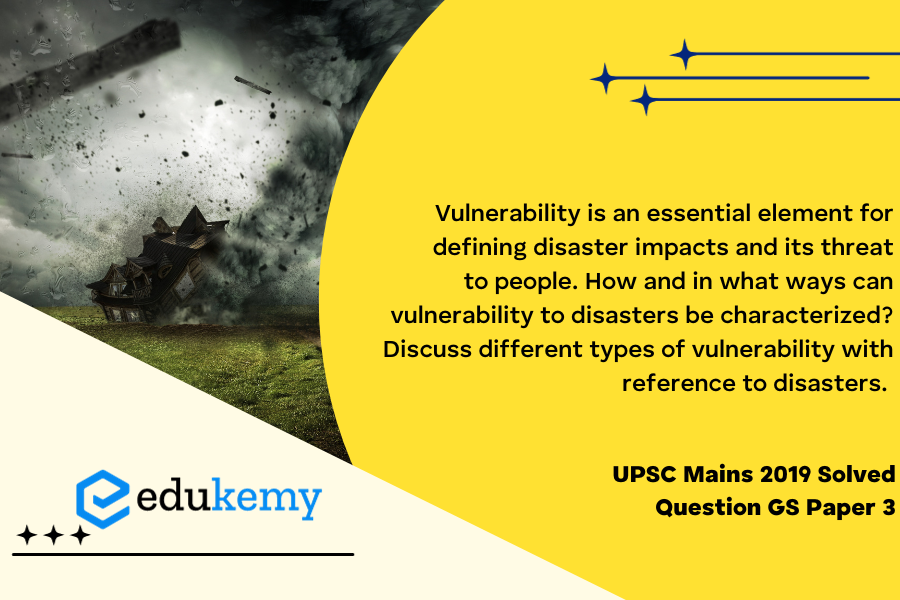Vulnerability serves as a critical determinant in understanding the profound impact of disasters on communities and individuals, highlighting the inherent susceptibility that certain groups or regions possess. Characterizing vulnerability to disasters involves a nuanced examination of various dimensions, encompassing social, economic, environmental, and institutional factors. Social vulnerability, for instance, emphasizes the disparities in a community’s resilience based on factors such as age, gender, and socioeconomic status. Economic vulnerability relates to the financial capacity to withstand and recover from disasters. Environmental vulnerability explores the ecological fragility of a region, while institutional vulnerability scrutinizes the effectiveness of governance and disaster management systems. Additionally, spatial vulnerability underscores the geographical exposure and susceptibility to specific hazards. These multiple facets of vulnerability collectively contribute to a comprehensive understanding of disaster risk, guiding policymakers and stakeholders in formulating robust strategies to mitigate the impacts of disasters on diverse populations and regions.
Tag: Disaster and disaster management.
Contents
Decoding the Question:
- In the Introduction, try to write how vulnerability is essential for defining impacts.
- In Body,
- Explain how vulnerability to disasters is characterized.
- Mention the types of disaster vulnerability.
- Try to conclude with an optimistic tone and preparedness for the future.
Answer:
Vulnerability is defined as the extent to which a community, place, structure, or organization is exposed to the threat. Many different factors determine vulnerability. A degree of vulnerability determines the impact of the disaster. So, the disaster event activities occur when the vulnerabilities and hazards meet.
Vulnerability assessment needs to be based on systematization and conceptualization of vulnerability. The concept of multi-dimensionality has been applied to analyzing vulnerability. It is typically described as a function of three overlapping elements:
- Exposure (the shocks and stresses experienced by the system),
- Sensitivity (the response of the system),
- Adaptive Capacity (the capacity of the system for any kind of adaptive action).

Only if the population and decision-makers know where and how vulnerable the system is and which social–economic, physical, and environmental factors play a major role in it, adequate measures can be implemented to reduce vulnerabilities to disasters. It involves two approaches:
- Scientific Approach: It includes the research line of practical measurement approaches of vulnerability and disaster risk reduction.
- Policy Approach: It provides information about the spatial distributions of vulnerability to different natural hazards upon which the authorities need to take action.
Different types of vulnerability:
Physical Vulnerability: It is determined by various aspects such as population density levels, the remoteness of a settlement, the site, design, and materials used for critical infrastructure and for housing. The physical vulnerability also depends upon the geographic proximity to the source and origin of disasters. Example: Wooden homes are less likely to collapse in an earthquake but are more vulnerable to fire.
Social Vulnerability: It refers to the inability of people, organizations, and societies to withstand adverse impacts to hazards due to characteristics inherent in social interactions, institutions, and systems of cultural values.
- It is linked to the level of well-being of individuals, communities, and society.
- It includes aspects related to levels of literacy and education, the existence of peace and security, access to basic human rights, and systems of good governance.
- Example: When flooding occurs some citizens, such as children, elderly and differently able, may be unable to protect themselves or evacuate if necessary.
Environmental Vulnerability: The potential impacts of events on the environment (flora, fauna, ecosystems, biodiversity). Example: Poorer families may live in squatter settlements because they cannot afford to live in safer (more expensive) areas.
Economic Vulnerability: The economic vulnerability of a community can be assessed by determining how varied its sources of income are, the ease of access and control over means of production (e.g. farmland, livestock, irrigation, capital, etc.). It means the level of vulnerability is dependent upon the economic status of individuals and communities.
Attitudinal Vulnerability: An attitude of society in a time of disaster matters also. A community that has a negative attitude towards change and lacks initiative in life is highly vulnerable to hazards or risks. They are more and more dependent on external support. They cannot act independently.
So, disaster management includes the holistic approach of assessing all these vulnerabilities to reduce the risk of disasters.
In case you still have your doubts, contact us on 9811333901.
For UPSC Prelims Resources, Click here
For Daily Updates and Study Material:
Join our Telegram Channel – Edukemy for IAS
- 1. Learn through Videos – here
- 2. Be Exam Ready by Practicing Daily MCQs – here
- 3. Daily Newsletter – Get all your Current Affairs Covered – here
- 4. Mains Answer Writing Practice – here


